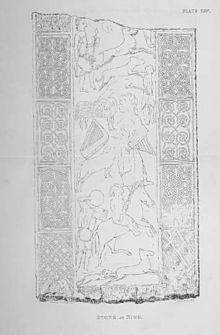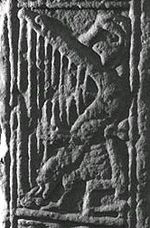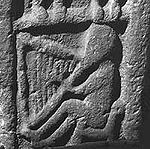- Origin of the harp in Europe
-
 Maedoc book-cover, Ireland, circa 1000 AD
Maedoc book-cover, Ireland, circa 1000 AD
The origins of the triangular frame harp are unclear. Triangular objects on the laps of seated figures appear in artwork of the early medieval period in Ireland, Scotland and other parts of North West Europe. This page outlines some of the scholarly controversies and disagreements on this subject.
Contents
Scottish Origins
The earliest descriptions of a European triangular framed harp i.e. harps with a fore pillar are found on carved 8th century Pictish stones.[1][2][3][4][5][6] Pictish harps were strung from horsehair. The instruments apparently spread south to the Anglo Saxons who commonly used gut strings and then west to the Gaels of the Highlands and to Ireland.[7][8][9][10] Exactly thirteen depictions of any triangular chordophone instrument from pre-11th century Europe exist and twelve of them come from Scotland.[11] Moreover, the earliest Irish word for a harp is in fact 'cruit', a word which strongly suggests a Pictish provenance for the instrument.[12] Only two quadrangular instruments occur within the Irish context on the west coast of Scotland and both carvings instruments date two hundred years after the Pictish carvings.[10] The first true representations of the Irish triangular harp do not appear till the late eleventh century in reliquary and the twelfth century on stone and the earliest harps used in Ireland were quadrangular lyres as ecclesiastical instruments,[5][10][13] One study suggests Pictish stone carvings may be copied from the Utrecht Psalter, the only other source outside Pictish Scotland to display a Triangular Chordophone instrument.[14] The Utrecht Psalter was penned between 816-835 AD.[15] While Pictish Triangular Chordophone carvings found on the Nigg Stone dates from 790-799 AD.[16] and pre-dates the document by up to thirty-five to forty years. Other Pictish sculptures predate the Utrecht Psalter, namely the harper on the Dupplin Cross c. 800 AD.
French Origins
The earliest drawings of triangular-frame harps appear in the Utrecht Psalter, written and illustrated in the early 9th century from a scriptorium in Rheims.[17] Ten of the illustrations show figures holding harp-like instruments, and in six of them the forepillar is clearly shown. The Utrecht Psalter was penned between 816-835 AD.[15] and found its way to the scriptorium at Christ Church in Canterbury, England 970AD. where several copies were produced.[17] Although portraits of the biblical King David playing a stringed instrument were already a feature of European religious manuscript art, manuscripts before this time show David with a medieval lyre rather than a harp.[17]
Similar Irish Instruments
The stone carvings attested to Ireland are all are found within a Christian context and the majority of carvings depict lyres or quadrangular ecclesiastical instruments that date from the 8th to the 12th century.[7][10][18] However lyres are physically different instruments from triangular harps and it is unlikely the characteristic medieval harp developed from them.[19] Early Irish monastic settlements prized the use of lyres within an ecclesiastical setting [20] and the instruments depicted, come in a variety of shapes and sizes and tend to be lyres rather than characteristic triangular harps.[7][7][21] Irish hymn texts of the period refer to the performance of hymns and psalms as being accompanied by a lyre and [18] such quadrangular instruments were used in religious ceremonies due to their small size from the introduction of Christianity to Ireland.[22] Gerard of Wales cites the “Cythera” Kithara of St Kevin playing by Irish abbots and bishops for chants and funeral lamentations. Such instruments were prized in Ireland well into the 12th century.[18][23]
From an Irish perspective, three distinct forms of lyre are evident; round top lyres as seen in the crosses at Ullard shows a quadrangular instrument with no forepillar,[22][24] and round topped lyres were common throughout northern Europe between the (5th-10th century) as can be seen in surviving examples namely the Sutton Hoo treasure hoard.[7] Curved arm lyres are depicted on the cross of scriptures at Clonmacnoise, the West Cross at Kells, and the Cross at Castle town County Offaly. Oblique lyres are depicted on the South Cross at Kells, the Crosses of Muirdach, and Monasterbonice.[7][25][26][27] The carving at Monasterbonice county Louth does show a type of chloroform triangular instrument, however the stone is weathered and unclear if the figure is playing a true triangular harp,[13] and others think it strongly resembles the Ullard lyre.[22] Another study argue that many such crosses from the pre-Norman period survive in Ireland, however what is striking is that there are no triangular framed harps,[26] Some early texts make the reference coir-cethar-chuir ‘four angled music' which refers to a four sided instrument.[26] Other contemporary Irish sources of the period, namely the Cotton manuscript still depict a plucked lyre correspond to the shrine of St Maelruain Gospel, the Durrow Cross lyre and the three stringed lyre carving of judgement of Solomon at Ardmore Cathedral.[7]
The first true representations of the Irish triangular harp does not appear till the late 11th century in reliquary on the St. Moedoc shrine,[7][10][13] while the Gospel of St Maelruain from the same period still traditionally depicts a lyre with three strings.[7] Other articles discuss the triangular harp was first appeared in Ireland at the start of the Anglo-Norman invasion.[7][10][18][22][28] The influx of English harpers to Ireland is also recorded in the Red Book of Ormond,[7] and the Dublin Merchant roll (c1190-1265) shows a contingent of English Anglo-Norman harpers within an Irish context, playing in the Anglo-Norman tradition.[7][29] Although, it is clear these musicians were playing a triangular English harp as seen by a sketch in the margin of the Harper Thomas Le Harpur (c1200), it is unclear if such an influx lead to a possible cross pollination between the invading Anglo-Norman and Irish harpers.[30][31]
Pre-European Origins
The knowledge and designs of harps and lyres probably arrived in ancient Europe via Grecian regions from the ancient Middle-East, for example a five thousand year-old Sumerian lyre is on display in the Mesopotamian section of the British Museum.
References
- ^ Montagu, Jeremy (2002). "Harp". In Alison Latham. The Oxford Companion to Music. London: Oxford University Press. pp. 564. ISBN 0198662122. OCLC 59376677.
- ^ The Anglo Saxon Harp, 'Spectrum, Vol. 71, No. 2 (Apr., 1996), pp. 290-320.
- ^ The Origins of the Clairsach or Irish Harp. Musical Times, Vol. 53, No. 828 (February 1912), pp. 89-92.
- ^ Scotland, Insight Guides. Josephine Buchanan 2003, pp94 Published 2003 Langenscheidt Publishing Group.
- ^ a b John T. Koch Celtic Culture: A Historical Encyclopedia 2006. Published ABC-CLIO, pp1276.
- ^ Scotland's Music: A History of the Traditional and Classical Music of Scotland from Early Times to the Present Day. John Purser (2007) Mainstream Publishing Group.
- ^ a b c d e f g h i j k l A New History of Ireland, prehistoric and early history. Daibhi OCoinin (2005). Oxford University Press.
- ^ J. Keay & Julia Keay. (2000): Collins Encyclopaedia of Scotland, Clarsach, p. 171. Harper Collins publishers.
- ^ History Literature and music in Scotland 1700-1560 Russell Andrew McDonald 2002 University of Toronto Press, Arts Medieval Recent introduction from Scotland to Ireland of the triangular harp.
- ^ a b c d e f Celtic Music History and Criticism Kenneth Mathieson 2001 Backbeat books p192
- ^ Alasdair Ross, "Pictish Chordophone Depictions", in Cambrian Medieval Celtic Studies, 36, 1998, esp. p. 41; Joan Rimmer, The Irish Harp, (Cork, 1969) p. 17.
Also: Alasdair Ross discusses that all the Scottish harp figures were copied from foreign drawings and not from life, in 'Harps of Their Owne Sorte'? A Reassessment of Pictish Chordophone Depictions "Cambrian Medieval Celtic Studies" 36, Winter 1998 - ^ J. Keay & Julia Keay. (2000): Collins Encyclopaedia of Scotland, Clarsach, p. 171. Harper Collins publishers.
- ^ a b c The Story of the Irish Harp its History and Influences Norah Joan Clark (2003) North Creek Press
- ^ Alasdair Ross discusses that all the Scottish harp figures were copied from foreign drawings and not from life, in 'Harps of Their Owne Sorte'? A Reassessment of Pictish Chordophone Depictions "Cambrian Medieval Celtic Studies" 36, Winter 1998
- ^ a b Snyder's Medieval Art, 2nd ed, p32. Luttikhuizen and Verkerk
- ^ http://www.stams.strath.ac.uk/research/pictish/database.php?details=186.
The Nigg stone is dated before the Utrecht Psalter and cannot have influenced the Pictish carvers to copy harp figures from the Ross study; date cited from Strathclyde University STAMS Pictish Stones Search Facility - ^ a b c The Anglo-Saxon Harp Robert Boenig Speculum, Vol. 71, No. 2 (Apr., 1996), pp. 290-320 doi:10.2307/2865415 This article consists of 31 page(s).
- ^ a b c d Fintan Vallely, ed (1999) The Companion to Irish Traditional Music New York University Press.
- ^ Graeme Lawson, An Anglo-Saxon harp and lyre of the ninth century, in "Music and Tradition", ed. Widdes and Wolpert, Cambridge 1991,
- ^ Roslyn Rensch (1989) Harps and Harpists Indiana University Press
- ^ Music related imagery on early Christian insular sculpture. Identification, context, function. (1991), (1995), pp135-99. Buckley. Imago Musica: International yearbook of Music Iconography.
- ^ a b c d The Ancient Music of Ireland Edward Bunting (2000) Curier Dover publications (originally published in 1843).
- ^ History Literature and music in Scotland 1700-1560 Russell Andrew McDonald 2002 University of Toronto Press, Arts Medieval
- ^ Old English Instruments of Music: Their History and Character (1910) Frances William Gaplin Methuen.
- ^ Alasdair Ross 'Harps of Their Owne Sorte'? A Reassessment of Pictish Chordophone Depictions "Cambrian Medieval Celtic Studies" 36, Winter 1998.
- ^ a b c Music and the Celtic other world from Ireland to Iona: Caren Ralls-Macleod (2000) Edinburgh University press
- ^ High Crossed of Ireland, an iconic and photographic survey, Harbison. P (1992) 3 volumes, Bonn RGZM
- ^ The Musical Times and Circular (1956) JASTOR Grey University of Michigan.
- ^ Dublin city archives MSG-I/I.MIID/A cited in A New History of Ireland, prehistoric and early history. Daibhi OCoinin (2005). Oxford University Press.
- ^ (Dublin 1992), p41 Philomena Conolly and Geferey Martin (ed) cited in A New History of Ireland, prehistoric and early history. Daibhi OCoinin (2005). Oxford University Press.
- ^ Kenith Sanger, Harper xxi. (spring 1996), p17
Bibliography
- John Bannerman, "The Clàrsach and the Clàrsair", in Scottish Studies, vol. 30 no. 3, 1991
- Keith Sanger and Alison Kinnaird, "Tree of Strings - Crann nan Teud", Kinmor 1992
- Seamus Roch Ryan, "The Sound of Revolution" 2006
- Henry George Farmer (1947). A History of Music in Scotland London, 1947 p. 280
- Roslyn Rensch (1989). Harps and Harpists Indiana University Press, 1989 pp. 125–127
- Francis Collinson (1966). The Bagpipe, Fiddle and Harp. from Traditional and National Music of Scotland, Routledge & Kegan Paul, reprinted by Lang Syne Publishers Ltd., 1983
Categories:- Composite chordophones
- Medieval Ireland
- Medieval Scotland
- Irish music history
- Scottish music
- Harps
- History of musical instruments
Wikimedia Foundation. 2010.



